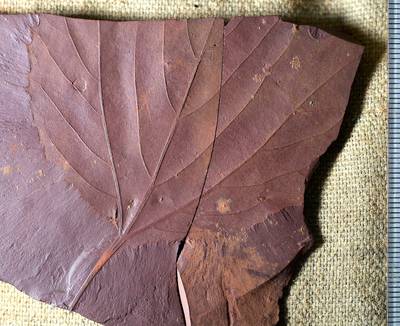Fossils found at an abandoned mine in Labrador have helped confirm that Eastern Canada had a much warmer climate when dinosaurs roamed the earth.
A team of paleontologists went to the old Redmond No. 1 mine site near Schefferville and found hundreds of specimens to analyze.
A Platanus leaf curated at the Yale Peabody Museum, recovered from the Redmond no.1 mine in 1958, and one of the already known leaf morphotypes, is also included in this study.
They went to the site because back in the 1950s fossilized leaves and insects found there led paleontologists to speculate that the area had once been much warmer. Now, using a tool called the Climate Leaf Analysis Multivariate Program, they were able to give the first published quantitative estimate of the region’s climate during the Cretaceous period.
The lead author of the paper produced by the team, National Geographic Explorer and McGill grad student Alexandre Demers-Potvin, said the mean temperature in the area would have been around 15 degrees Celsius, with high humidity and hot summers.
“We were able to put numbers on what had been estimated before,” he said. “By quantifying the temperature and precipitation and all sorts of measurements for this site its now easier to compare it with sites around the world with a similar climate.”
Demers-Potvin said the area was suggested to him by Professor Hans Larsson, Vertebrate paleontologist and director of the Redpath Museum at McGill University, who is now his graduate studies advisor.
“I had no idea that we had fossils from the age of the dinosaurs that close to home,” he said in a phone interview with the Labrador Voice. “When I looked at what was already known of this site, it wasn’t much.”
He said there had been very little written about the site and approximately 40 insect fossils had been found there in the past, with only five species identified.
“They had been pretty much forgotten by the world, except by people who worked in the mines or who work in paleontology in the area,” he said “When this site was found in 1957 people would find broadleaf tree leaves in there, and at another site nearby people would find almost complete tree trunks standing up, almost a meter in diameter.”
A new Redpath Museum specimen, spectacular fossilized tree leaves, were collected in the Redmond no.1 mine in August 2018. It is the first leaf of that type to be found in this site, and has been included in the Cretaceous climate estimate for the region. CONTRIBUTED
Those samples found in 1957 are used in the study published by Demers-Potvin and the team, as well as the hundreds they found at the old mine site, which has large piles of broken rocks containing fossils. The team found around 220 fossilized leaves and approximately 360 insects.
Demers-Potvin said when they went to the site they didn’t have high expectations but were pleasantly surprised by the large number of fossils they found.
They were only on the site for three weeks, he said, and were only able to collect what they could find on the surface.
He would like to go back and dig a little deeper into the rubble, literally and figuratively, to shed more light on what Eastern Canada looked like in the past.
Now the team is looking more into the fossils they found on the trip last summer to try to identify them and add another piece to the picture.
He’s certain as well, he said, that there are far more fossils to be found in the Labrador Trough and if more exploration was done in the area that would be borne out.
None of the research would have been possible without a number of organizations, he said, including the Fonds de recherche Nature et technologies Québec, a National Geographic Society Early Career Grant, the Northern Scientific Training Program, a Redpath Museum Class of 66 Award, and a NSERC Discovery Grant secured by his advisor.















